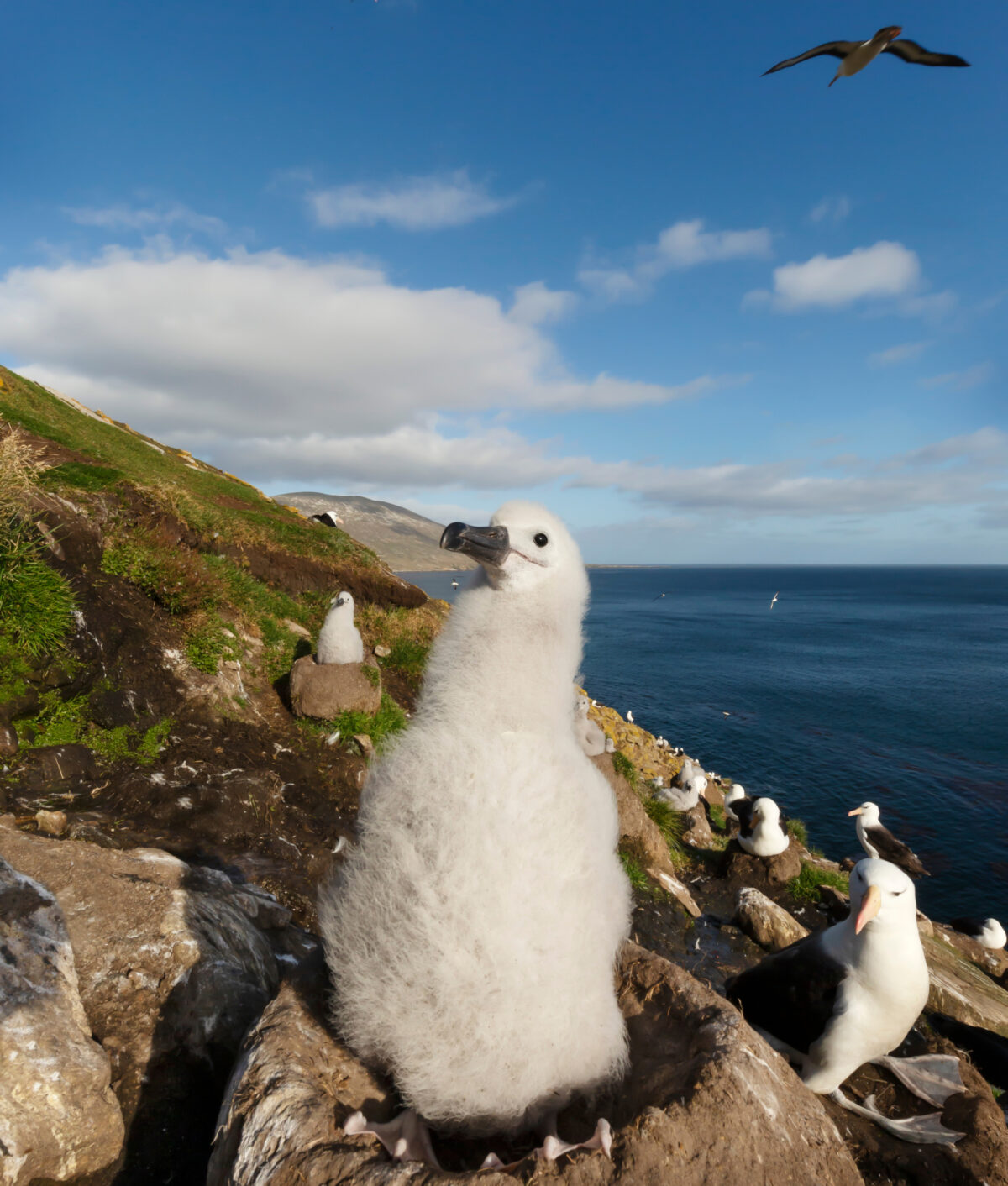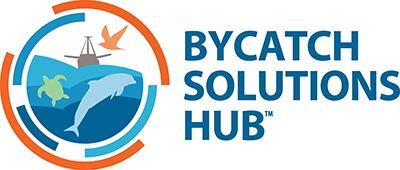Bycatch
Seabirds
Bycatch in fisheries is considered the greatest threat to seabirds while at sea.
Nearly one-third of all seabird species are considered threatened with extinction, including 17 of the 22 albatross species and 7 petrel species. Because of their large wingspan, albatrosses and large petrels are more likely to collide with cables running from the fishing gear to the vessel. Seabirds are more common in temperate regions, therefore fisheries north of 23°N and south of 23°S latitudes pose the greatest threat to these large seabirds. However, in all latitudes there are seabirds attracted to fishing vessels, leading to a high risk of getting caught or entangled.
Risks for sea birds

Black-browed albatross chick
Seabirds target bait and discards when fishing gear is deployed and hauled, often resulting in the bird becoming hooked or entangled. In longline fisheries, seabirds forage on bait and can become hooked and dragged underwater, while in in gillnet and trawl fisheries they scavenge fish caught in the nets which leads to collision with fishing gear (net cables) and entanglement in the nets themselves, all of which can lead to drowning and subsequent death.
Mitigation Methods
In general, seabird mitigation methods involve decreasing the attractiveness of the vessel and gear to seabirds and decreasing the amount of time that fishing gear is near or at the surface where it is most accessible to diving birds. The less fish discards there are on or around the vessel the less seabirds there will be during the set and haul. In addition, the quicker baited hooks and nets sink and the quicker they can be retrieved when being hauled to the surface, the fewer seabirds will get hooked or entangled.
Fishery Impacts
- Require a combination of at least two best practice mitigation methods when setting and retrieving.
- Support the implementation of hook shielding devices when fishing in regions where high interaction rates with albatrosses and petrels occur.
- Provide best methods handling and release training to the captain and crew.
- Require 100% coverage on all fishing vessels, combination of human observer and electronic monitoring, with detailed bycatch data collection.
- Ensure 100% compliance with all management measures specific to seabirds, both at the country and management organization level.
- Limit offal discharge to only when fishing gear is on-board and properly stored.
- Clean the trawl net of any discards or fish parts between sets.
- Provide best methods handling and release training to the captain and crew.
- Add weights to the codend and net belly to increase the sink rate and hauling angle.
- Require 100% coverage on all fishing vessels, combination of human observer and electronic monitoring, with detailed bycatch data collection.
- Ensure 100% compliance with all management measures specific to seabirds, both at the country and management organization level.
- Transition to alternative gear types effective for the fishery.
- Restrict fishing in regions and times of the year with high bycatch rates, especially where fishing overlaps with albatross and petrel populations in temperate and polar seas.
- Set gillnets at a minimum depth of 20 m.
- Provide best methods handling and release training to the captain and crew.
- Set a tracking device on all gillnets, with initial emphasis on driftnets, so nets can be tracked and recovered if lost.
- Require 100% coverage on all fishing vessels, combination of human observer and electronic monitoring, with detailed bycatch data collection.
- Ensure 100% compliance with all management measures specific to seabirds, both at the country and management organization level.
- Provide best methods handling and release training to the captain and crew.
- Require 100% coverage on all fishing vessels, combination of human observer and electronic monitoring, with detailed bycatch data collection.
- Ensure 100% compliance with all management measures specific to seabirds, both at the country and management organization level.
In longline fisheries, seabirds are at the greatest risk when gear is either being set or retrieved. During these times, baited hooks are at or near the surface and attract seabirds. As baited hooks sink they become more difficult for the birds to reach with most of the risk removed once they sink to below 10 m depth. Therefore, the majority of seabird bycatch mitigation methods focus on preventing seabirds from being able to prey on the bait while it is being set and first begins to sink. Proven mitigation methods include setting at night when birds can’t see the hooks, weighting the gear so it sinks faster, putting up bird scaring or streamer lines which act to scare birds from the gear being set to give it more time to sink. Devices that encase the hook during the setting process and open at depth have also proven effective.
17 of the 22 albatross species and 7 seven petrel species are classified as either threatened or endangered.
Albatrosses and petrels are the most impacted seabirds due to their large size and pelagic feeding behaviors. This has led to 17 of the 22 albatross species and 7 seven petrel species to be classified as either threatened or endangered. However, the impact on them is greatest in temperate and polar seas, north of 23°N and south of 23°S latitudes. Longline fisheries in these regions are of particular concern and require multiple mitigation measures to minimize impacts of these seabirds.
General Recommendations:
Seabird interactions with trawls occur as either strikes on the warp wires while the net is being deployed or entanglement with the net itself, especially during hauling. If a seabird becomes entangled in the net while hauling, it can be disentangled on the deck with proper handling and given time to recover. However, very little can be done for seabirds that become entangled during the set or that collide with gear cables. Therefore, the most effective methods at mitigating bycatch risk is to minimize the attractiveness of the vessel and net to seabirds, especially during the set. Similar to longlines, albatrosses and petrels are particularly vulnerable due to their large size.
The most effective methods to minimize the attractiveness of the vessel and net to seabirds is through management of offal discharge and cleaning the net between sets. Offal discharge, or the discharge of processing waste and bycatch, attracts seabirds to the vessel and increases the likelihood of cable strikes and entanglements if discharge occurs close to or during fishing. Limiting discharge to when fishing is not occurring or about to occur has shown to greatly reduce seabird interactions with trawl gear. In addition, seabirds become entangled in the net when trying to feed on fish and fish parts that are stuck onto the net. Removing stuck fish before setting greatly reduces the chances of seabird entanglement. These two methods combined are the most effective proven mitigation methods.
General Recommendations
Seabirds become entangled in gillnets when diving to feed on entangled fish. In order to minimize interactions with seabird, gillnets need to be set at least 10 m deep, preferably at a minimum depth of 20 m. Entangled seabirds will eventually drown, therefore decreasing soak time is the only way to decrease the mortality rate of entangled seabirds.
General Recommendations
Purse seines present a much smaller threat to seabirds than longlines, trawls, or gillnets, but seabirds can still get entangled while diving to feed on fish stuck in the net. Therefore, it is still important to require documentation of all encounters and proper handling and release training to the captain and crew.
